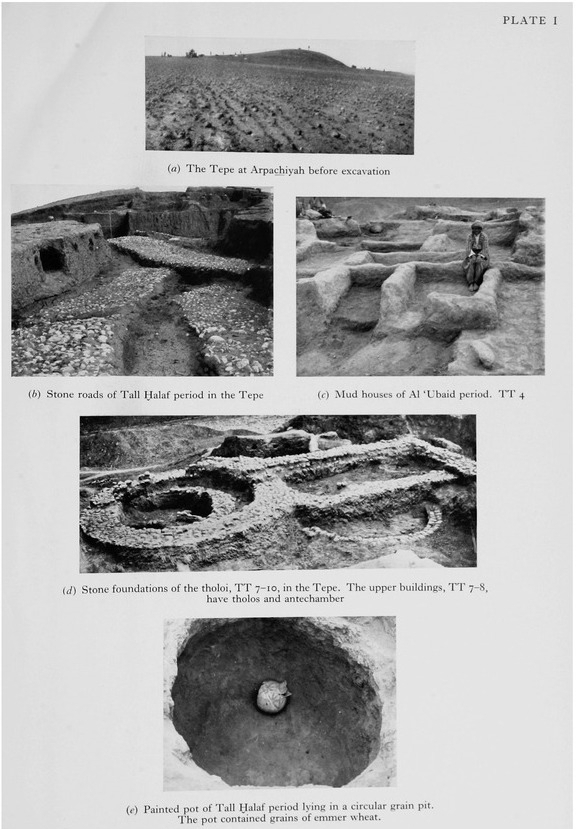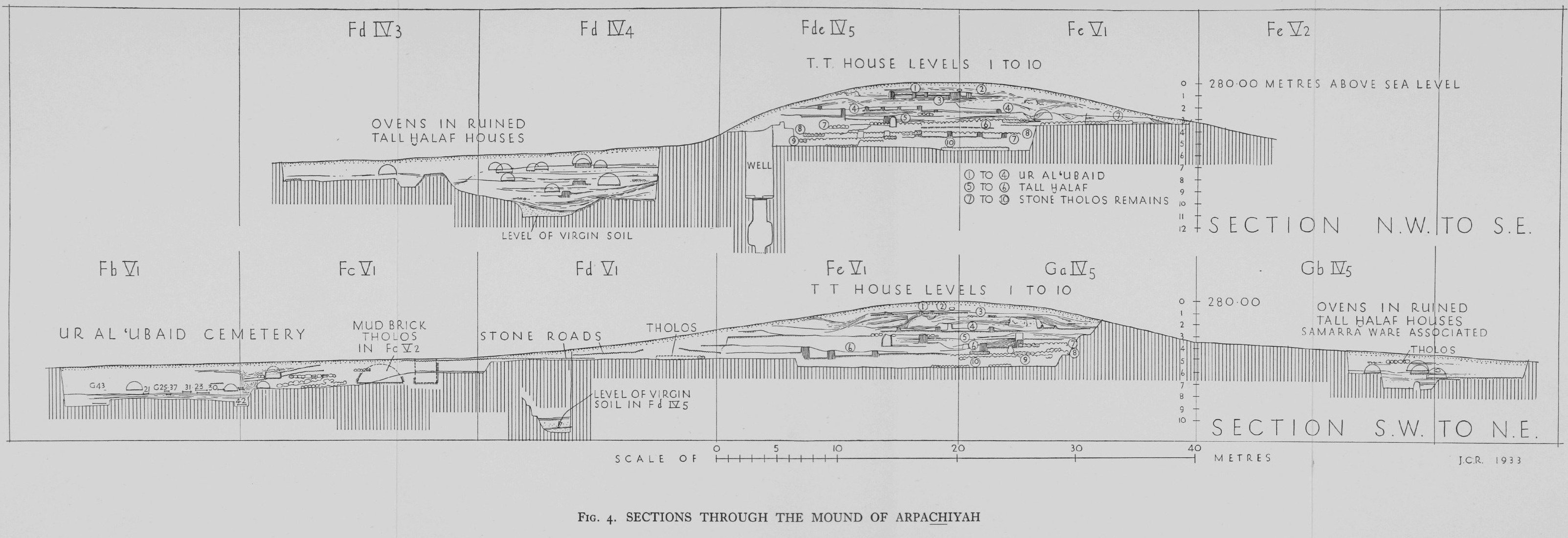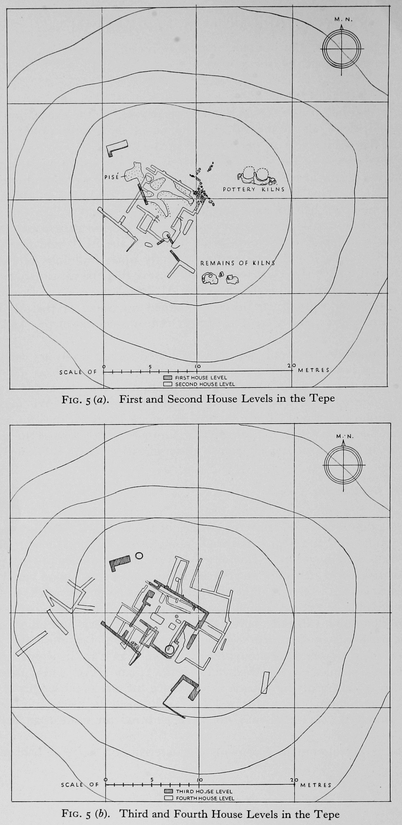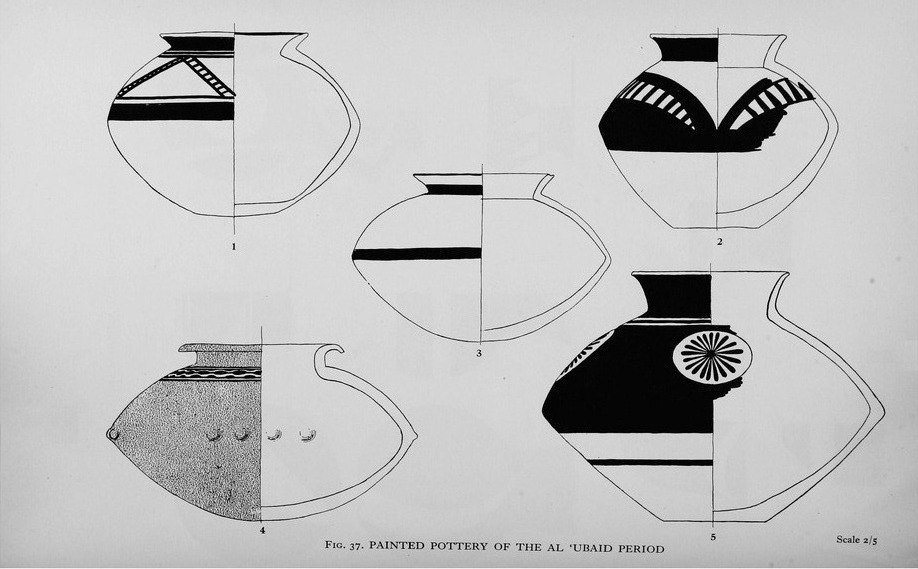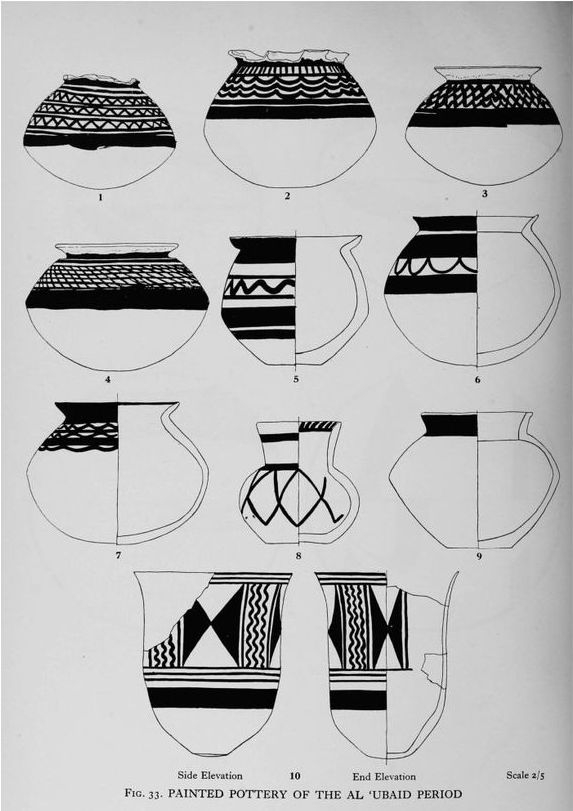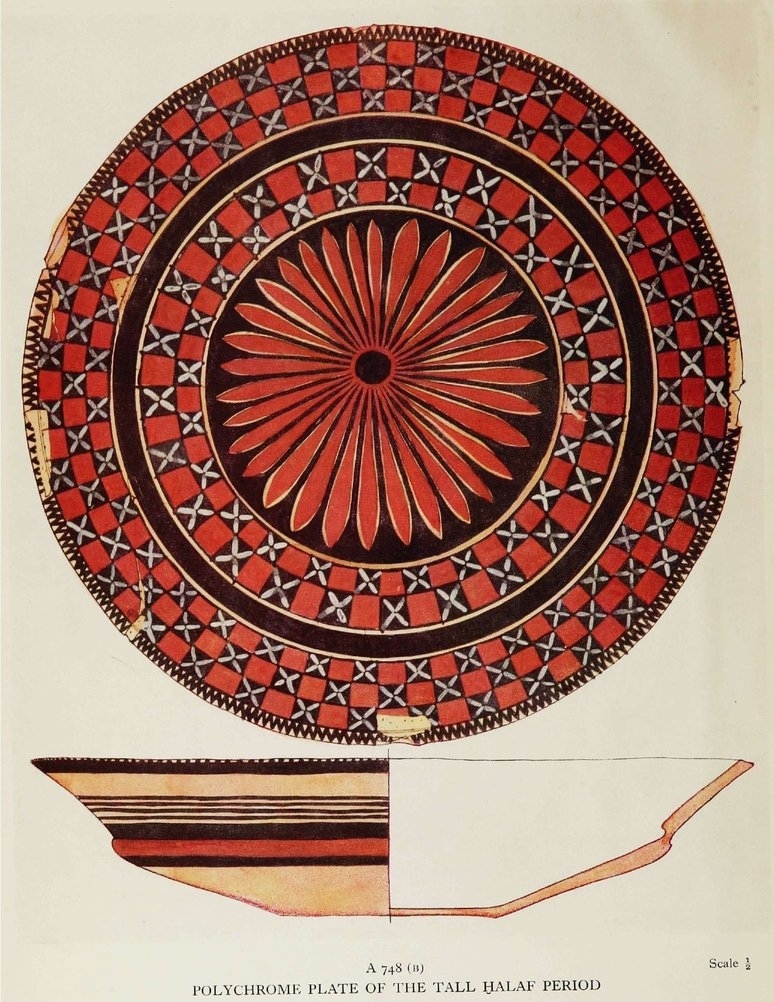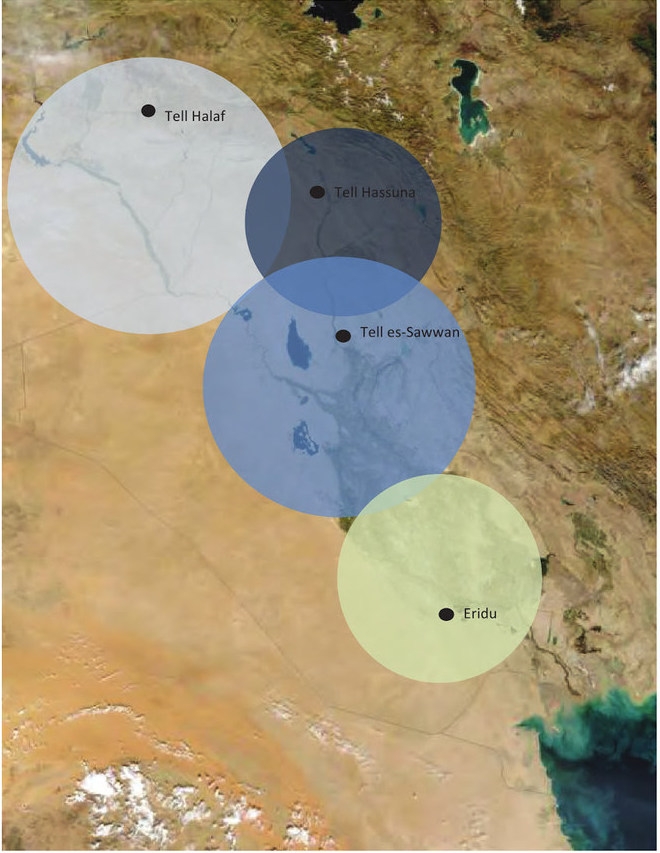|
Other Archaeological Sites / The Neolithic of the Levant (500 Page Book Online) Pre-Historic Tell Arpachiyah (Tepe Reshwa) ProofRead and Updated March 21st 2020 See: Tell Arpachiyah in A Dictionary of Archaeology by Ian Shaw and Robert Jameson (2008)
Early in the chalcolithic period the potters of Arpachiyah in the Khabur Valley carried on the Tell Halaf tradition with a technical ability and with a sense of artistry far superior to that attained by the earlier masters; their polychrome designs show a richness of invention and a painstaking skill in draughtsmanship which is unrivaled in the ancient world ... (A)
(1) Prehistoric Assyria: The Excavations at Tall Arpachiyah by M. E. L Mallowan (1933) [PDF]
Situation -- Climate -- Population -- Natural Resources -- Arpachiyah lies in a gently undulating downland, treeless since the days of Turkish deforestation, with reasonable access to water: it has good pasture in rainy seasons though drought is always liable to endanger flocks: its greatest wealth lies in the richness of its soil with its splendid harvests of grain. At intervals of every few miles are small villages whose inhabitants are engaged in agriculture, pasture and the growing of fruit. These villages, which lie close to one another in the neighbourhood of Mosul and Nineveh, become less frequent as one approaches the foot-hills of the Jabal Maqlub on the east. The climate of Assyria is generally more temperate than that of Babylonia and man here does not have the same desperate struggle for existence that besets the nomad Arab of the barren desert. Here then different races speaking different languages have entered through the mountain passes and have marched down the river valleys and settled in the plain. The pursuit of agriculture and a pastoral life allowed these communities leisure, if they wished, for the cultivation of the minor arts; and that natural love of colour which seems so often to be associated with a mixture of mountain blood must have found an outlet in the production of woven fabrics, leather and fancy basketry; and as we know for certain, in the output of painted pottery. In the painting of pottery the inhabitants of Arpachiyah excelled and their finest ware bears comparison with any other pottery of the ancient world. The discovery of kilns proves that much of the pottery was manufactured on the site. Further we must infer that pottery was an important trade commodity and that it was made for export to Nineveh in particular and traded to villages in the neighbourhood. Similarly, it is certain that Arpachiyah must have used Nineveh as its trading mart and we may suppose that it was the strength of Nineveh that enabled Arpachiyah to pursue agriculture and potting in peace. Defenceless position of Arpachiyah The ancient Arpachiyah resembles many of the modern villages of the neighbourhood in that it lies in a naturally exposed and defenceless position. To the north and to the west the horizon is obscured by two hillocks which overlook the site, to the east and to the south lies the open plain: the original settlement lay in a hollow and in wet weather water from the high ground must have drained on to it. Indeed the poorness of the drainage on the site is shown by the number of stone roads that had to be constructed because of the sticky soil underfoot. These tracks were as a rule not more than 1-2 metres wide and were made from pebbles taken from the banks of the Tigris or Husr; they were packed hard and had flat surfaces suitable for pedestrian and mule traffic: the soil beneath the roads was found to be thickly packed with potsherds to give a better drainage. In wet weather our own men found these tracks much easier to walk on than the sticky clay subsoil of their own village. (Plate I b) But in addition to the unstrategic position of the settlement, excavation failed to reveal the presence of any adequate town defences and military weapons were conspicuous by their absence. Only in the lower levels the thick-walled circular buildings in the centre of the mound could have served as a sanctuary for a small number of people. All the available evidence tends to show that at Arpachiyah there lived a peaceful community of peasants and potters who tilled their lands and bred their cattle and baked and painted their pottery for their own delight and profit: in times of stress, like the village dwellers of ancient Greece, they could seek the protection of the walls of their parent city and take refuge behind the barriers of Nineveh. Topography Plate I (a) : Perhaps the outstanding characteristic of the ancient mound is its smallness and compactness. Its most obvious natural feature before excavation was a low mound in the form of a hillock, rising 5 1/2 metres (20 ft.) above the level of the modern mule track. Surface debris lay thickest on the lower slopes of the Tepe (Turkish) and became scarcer in proportion as the sides of the mound approached the flat levels of the surrounding barley fields. The principal surface debris was in fact concentrated within an area roughly 100 metres square ... The dimensions of the ancient village were approximately those of the average modern village in the neighbourhood and we may not be altogether rash in hazarding a guess that in most periods the settlement would have had no more than two hundred houses in all. Surface Indications The debris on the surface which had induced us to investigate the site consisted of flint and obsidian knives and scrapers, fragments of stone vases and painted potsherds of such fineness that we considered that if fortune favoured us with only a few intact vessels the site would have justified the excavation. In this our most sanguine hopes were exceeded, for at the end of eight weeks' work we had secured a collection of painted pottery richer than any other yet recovered from Mesopotamia and in addition some eight hundred other objects of varying importance and interest; the majority well stratified on distinct house floors or in graves so that we could assign all the main categories of our material to distinct periods of development. Order of Excavations The main objective of the excavations was the mound known as Tepe Rashwa. But before attempting to investigate what was obviously the core of the site it was deemed advisable to test the surrounding soil on the flats all around in order to gain some knowledge of the general stratification and sequence of periods; and further to enable the men, at least half of whom had not been employed on excavations before, to obtain some initial training. As a result we were able to excavate the most important portion of the site with some knowledge of local conditions. This method of approach was in all these respects most satisfactory; it is only to be regretted that it was impossible in one short season to excavate the Tepe itself down to virgin soil. The Cemetery The main importance of the excavations on the outskirts of the mound was the discovery on the west side of the cemetery belonging to the latest occupants on the site. Forty-five graves in all were excavated in this cemetery: they consisted of inhumation burials, mostly oriented East by West, and of a number of fractional or partial burials with incomplete skeletons. Associated with them were painted pots, clearly related in style to the Ubaid ware of southern Babylonia ... The graves discovered could easily be fitted within the span of two or at the outside three generations and as the excavated house remains show, the Ubaid period can only have covered the latest and shortest portion of the total length of time during which Arpachiyah was inhabited. Remains underlying the Cemetery The remains underlying and disturbed by those of the Ubaid period were mostly Western in their affinities and the vast majority of the pottery belonged to the group known as Tall Halaf ware, from its first discovery at Tall Halaf on the river Habur in Syria. Associated with it, though in a very small proportion, were examples of Samarra ware. We may therefore divide the majority of the finds at Arpachiyah into two main groups: the latest belongs to the Ubaid period of southern Babylonia; and rigidly separated from it, the earlier group belongs to the Tall Halaf-Samarra complex, though even here Iranian influence was ever present. It is the earlier Tall Halaf group that contains by far the most important material on the site and covers the main length of its occupation. Excavation of the Tepe The second half of the season, which was devoted to the excavation of the Tepe itself, definitely confirmed and elucidated the results obtained from the more damaged levels on the outskirts of the mound. The total height of the Tepe above virgin soil was 10 1/2 metres (34 feet). From the section (Figure 4) it will be seen that our excavations were conducted to a depth of 5 1/2 metres; that is to say that the excavated buildings in the mound represent just over half the total accumulation of debris. In the Tepe ten superimposed building levels were excavated: the top five levels were poorly built mud-brick houses of the Ubaid period; the fifth level had its foundations resting directly upon buildings of the Tall Halaf period and it was therefore not surprising that the remains were here mixed and contained Tall Halaf as well as Ubaid ware.The sixth and subsequent levels contained no traces of the Ubaid pottery whatsoever and were exceedingly rich in material of the Tall Halaf group. As the mound is still only partially excavated, house levels are numbered from top to bottom and for convenience will be referred to as T T 1-10; T T 1 representing the latest period of occupation on the site and T T 10 the earliest building level discovered up to date on the Tepe ... From this we will learn the relation of the main periods at Arpachiyah to those already known in Mesopotamia and Syria. Building levels in the Tepe TT 1-4 --- These four house levels covered a depth of 2 1/2 metres from the surface of the mound. Houses were very poorly built; sometimes of mud-brick, sometimes of lumps of stiff clay or pise (French : rammed earth). Walls were never more than one brick thick, floors were of beaten clay, roofs of reeds and matting. In no case did walls of this period stand more than a few inches in height and often they were totally destroyed so that it was impossible to extract a coherent ground plan. The most that we may infer is that these can only have been dwellings of very humble peasants: houses were closely huddled together, there were a few miserable alleys between them, rooms were sometimes no more than 2 metres in width and the whole bore a suspicious resemblance to a slum (Plate 1 c). These miserable dwellings could hardly have been in existence for any great length of time and we may reasonably guess that T T 1-4 can easily be fitted into the span of one hundred years and may not have endured for more than hall that time. These levels all contained remains characteristic of the Ubaid period but the large mass of pottery belonging to this stage of habitation was found not in the houses but in the cemetery on the west side of the Tepe. The forty-five graves excavated must have contained the bodies of peasants who had lived in these houses and the funerary offerings that accompanied the skeletons illustrated the handiwork of this period far more fully than the scanty material found in the houses themselves. TT 5 --- At 3 metres below the surface of the Tepe the houses changed in character. They were altogether better built and more spacious in plan and the walls were built of pise. The rooms excavated were evidently part of a larger complex, possibly a single unit, the extremities of which had been lost for ever by the denudation of the mound and the cutting away of the sides of the Tepe. The more spacious rooms of T T 5 indicate that it is the work of Tall Halaf builders: that the two stocks did not live together in harmony is shown by the complete change of material in T T 1-4 where all traces of the older elements had vanished ... Also there was evidence that in the Ubaid cemetery grave-diggers had deliberately destroyed Tall Halaf house remains. Tall Halaf Peoples supplanted by the Ubaid It is more than probable that the Tall Halaf peoples abandoned the site on the arrival of the new-comers from Babylonia; and with the disappearance of the old element the prosperity of the site rapidly declined; for although the new-comers were apparently strong enough to eject the older inhabitants, yet they appear to have been a poor community, already degenerate: their houses were poorly built and meanly planned, their streets no longer cobbled as in the Tall Halaf period and the general appearance of their settlement dirty and poverty stricken in comparison with the cleaner buildings of the healthier northern peoples who were their predecessors. In addition their pottery was often coarse, carelessly made and baked in inferior kilns; and they had lost the source of the fine ferruginous clays which were in use in Tall Halaf times. Peculiar contours of the site due to sudden diminution in size With the disappearance of the Tall Halaf stocks, Arpachiyah must have greatly diminished in size and it is largely this that is responsible for the peculiar contours of the site. The majority of the Ubaid settlers concentrated themselves into a camp on the centre of the site which in consequence rapidly increased in height. It is probable that there was some sort of occupation round the base of the mound but denudation and constant modern ploughing has destroyed all evidence of it. The invaders had evidently made a wholesale destruction of all standing buildings and converted some of them into a cemetery. Apart from potsherds these houses contained very few objects. Cereals Most interesting was the discovery of numerous grains of wheat and barley ... The samples from T T 5 consist of the naked unhusked grain of emmer wheat (Triticum dicoccum) together with grains of barley: there is a preponderance of the emmer grain. The samples from the well in T T 4 consist almost entirely of barley. Grains of wheat and barley were in fact forthcoming from every level and those found in the Tall Halaf houses are certainly the earliest specimens of any cereal hitherto discovered in Mesopotamia. Well in the Tepe Another discovery of interest in connexion with the houses was a finely built well, apparently disused about the time that T T 4 was built and at that time turned into a rubbish pit and later into a granary, as it was filled with a mass of rubbish consisting of bones, sherds, charred wood, straw and barley. Probably this well was the main water-supply for the houses on the Tepe throughout the Tall Halaf period; but at some time in the Ubaid occupation it was abandoned as a water-supply and apparently used as a granary; the quantity of wood found within it suggests that the sides may have been wood-lined: analogous are certain ancient predynastic Egyptian silos which appear to have been lined with straw matting. General characteristics of houses of the Tall Halaf period TT 6 --- The sixth and richest settlement lay at 4 metres below the surface. Nothing that was found at this level could be ascribed to the Ubaid period. Everything associated with the buildings belonged to the fullest phase of development of the Tall Halaf period. The most important building was a spacious house standing in the centre of the Tepe: as in the fifth settlement the ends of the house had been destroyed with the denudation of the mound. This was the largest house discovered on the site. The rooms appear to have been long in proportion to their breadth: there was no trace of a central court and in this respect all the houses at Arpachiyah show a marked difference from the south Babylonian houses with their rooms grouped about an open courtyard. The house walls and floors were of beaten clay or pise, the roof of beaten clay, wood and matting. Walls were more solid structures than those of the later settlements; some of them were nearly half a metre thick and had been faced with a solid mud plaster which had been burnt to terra-cotta in the subsequent destruction of the house by fire. Polychrome pottery common in TT 6 The most important characteristic that distinguished the ware of T T 6 from that of all previous or subsequent periods was the frequent use of polychromy, much of the pottery being trichrome. This ware represents the climax of the Tall Halaf period and in technique is unsurpassed by any other painted prehistoric pottery in Mesopotamia. Excavations down to virgin soil outside the Tepe Although T T 10 was the lowest level to which excavations were conducted in the centre of the mound, on the outskirts excavations were made over a fairly wide area down to virgin soil so that we may claim to have uncovered all the main occupation levels on the site. The cross-section through the mound on to outlying areas of excavation would indicate that we may expect below T T 10 at least five more occupation levels, though it is difficult to forecast this with certainty. On the outskirts of the mound houses were of more flimsy material; in many cases they appear only to have been of wood and were indeed huts rather than houses, so that levels are far less rigid than on the centre of the mound. Ubaid Period Ubaid Pottery at Arpachiyah --- One would be disinclined perhaps to equate the last period of occupation at Arpachiyah with that of Ubaid on the evidence of pottery alone: for the pottery of this group is essentially a black on buff ware with many variations both in shape and in decoration; the ware varies considerably even on neighbouring sites in south Babylonia itself and obviously is still more likely to show greater differences when it comes to Assyria, so far from its main centre of distribution. Generally speaking, the ware of this period at Arpachiyah seems, as we might expect, to be a degeneration of the south Babylonian species. The variety of shape and design is more restricted than in the south and the absence of ring bases, the poor quality of clay and inferior firing, together with certain types which seem to be related to pottery of the Uruk-Jamdat Nasr type are all indications that this pottery comes late in the series. But it is important to observe that some of the types are closely similar to the best material of the early Ubaid and it would seem therefore that the best traditions of the period were still in the potter's memory. Tall Halaf Period Tall Halaf ware a homogeneous series --- Identifications here are so numerous that it is unnecessary at this stage to mention details. This period begins with the first settlement on virgin soil and continues into T T 6. The pottery is in use for at least ten main building periods and probably more: it covers by far the longest period of occupation on the site. It is important to observe that it is an entirely homogeneous ceramic series. In the beginning its outstanding characteristics are naturalistic animal designs, such as leopards, birds, fish and snakes but the characteristic stippled decoration, the use of a slip and the highly distinctive Arpachiyah bowl type with bevelled base are also present. Distinction in style and baking between the early and the fully developed Halaf ware --- Only in the earliest period are designs and shapes restricted and the baking and clay inferior. Gradually this pottery develops and we find the finest examples of the potter's skill in T T 6, where we have polychromy, including trichrome decoration and an enormous variety of stylized abstract designs without any of the traces of naturalistic animal drawing that characterize the earliest series. (2) ARPACHIYAH 1976 by By ISMAIL HIJARA et al in Iraq Volume 42 (1980) The tell at Arpachiyah in Northern Iraq has proved to be a key site in providing detailed information concerning the Halaf culture. At the suggestion of Dr. Joan Oates and Professor David Oates an eight week season of excavations was begun on the site on 5th September 1976 ... The basic intention of these excavations was to expand on Sir Max Mallowan’s 1933 season at Arpachiyah and to improve on the archaeological sequence that he established and which was published in this journal in 1935 ... A New Radiocarbon Date from Arpachiyah During the recent excavation at Arpachiyah radiocarbon samples were taken from various layers for analysis at the British Museum Radiocarbon Laboratory. A charcoal piece was removed from Layer 25 which belongs to the very end of Phase H Two. The Halaf Period occupation below Layer 25 is some 2 metres thick. The result of the radiocarbon determination is based on the conventional 5570 year half-life and is as follows: Arpachiyah. BM-1531. 6930 +/- 60 b.p. or 4980 B.C. -- Phase H Two (late) Layer 25 This date is very reasonable if we compare it to other radiocarbon dates for sites of the Samarran culture, usually dated to the second half of the sixth millennium B.C.
Tell Sawwan. P-855. 7456 +/- 37 b.p., 5506 B.C. Level I floor The above radiocarbon dates confirm, with the exception of P-857, that the Halaf culture in Mesopotamia started at the end of the sixth millennium B.C., overlapped with the Samarran culture for a very short period in the last two centuries of this millennium and eventually succeeded the Samarran culture in the beginning of the fifth millennium B.C. The ceramic and scientific information obtained from other Mesopotamian sites confirms this view:
Nineveh: The Halaf pottery came from the deep sounding at Nineveh 2c and
belongs to the Early Halaf Period. Hassuna : The Halaf pottery started with Level VI. Tell Sawwan: Most of the Halaf pottery came from the top of the upper level or from unstratified levels and belongs to the Early Halaf Period.
Choga Mami : The Halaf pottery from Choga Marni came from a well dated to the
Late Halaf Period. This well was originally dug later than the Transitional Period
which dates as follows: Chagar Bazar. P-1487. 4715 +/- 77 B.C. in Level 11-12 Note: By the early 6th millennium people had moved into the foothills of northern Mesopotamia, a region which could support agriculture without the need for irrigation. These people are known from Tell Hassuna in Iraq, the type-site of the Neolithic Hassuna culture ... The site extends across 2 hectares and contains multiple cultural levels in which the development of the Hassuna culture and its relationship with subsequent regional cultures can be traced. The Hassuna cultural traditions of central and northern Mesopotamia intersect with the Samarran traditions of central and southern regions. The Samarran culture marks the extension of agricultural societies southwards from central Mesopotamia where people established large villages and developed irrigation systems at sites such as Tell Sawwan and Choga Mami. Irrigation allowed the villagers to increase their crop yields and settle the Mesopotamian plains. The stratigraphic sequence at Tell Hassuna documents the development of the Hassuna-type ceramic tradition, the [subsequent] introduction of Samarran pottery into the Hassuna assemblage and the Samarran replacement by the successive Halafian traditions. Halaf and Ubaid Cultures (circa 6000-5400 and circa 5900-4200) The majority of Halafian sites are small (1-3 hectares) such as Tell Hassuna and Tell Halaf and seem to have been self-sufficient village communities ... The peoples of the Halafian culture lived primarily in northern Mesopotamia but their characteristic pottery has been found far afield; the sites of Tell Arpachiyah (Tepe Reshwa) in Iraq and Chagar Bazar in Syria are thought to have functioned as specialized pottery manufacturing and distribution centres ... There was considerable regional variation in local ceramic styles in the sixth millennium and so the Halaf ceramic wares are significant as one of the few styles to be found across sites with diverse traditions, from south-east Anatolia to southern Mesopotamia.
The Halafian culture overlaps with the start of the Ubaid tradition, a late Neolithic group of villagers who settled in southern Mesopotamia. The Ubaid culture had a very long duration in the southern Mesopotamian alluvial plains, initially developing alongside Samarran traditions as early as the seventh millennium and being replaced by the Uruk culture in the late fifth millennium. Ubaid traditions spread to northern Mesopotamia from around 5300, following the Tigris and Euphrates Rivers and gradually replacing the Halafian traditions ...
(4) The Burnt House at Arpachiyah: A Reexamination by Stuart Campbell in Mallowan's excavations at Arpachiyah in northern Iraq in 1933 uncovered a Burnt House at the summit of the mound. Although the importance of the discovery has been recognized ever since as vital evidence for society in the late Halaf (mid-fifth millennium B.C. circa 5300 caibrated B.C.) in northern Mesopotamia, the basic data have never been reviewed and no comprehensive interpretation has been put forward ... It is suggested that the Burnt House was the last in a series of structures where exchange --- of obsidian among other commodities --- took place within a formalized social context and it was through this role that Arpachiyah acted as a center of regional integration. INTRODUCTION Arpachiyah is a small superficially insignificant tell now surrounded by a housing estate on the edge of a village just outside the urban sprawl of Mosul in northern Iraq. It is an unlikely spot for one of the key prehistoric sites of the Near East. It was the first excavation of the British School of Archaeology in Iraq, directed by Max Mallowan in 1933 and published with remarkable speed two years later (Mallowan and Rose 1935) ... In many ways though the site has been rather neglected. Virtually no attempt has been made to reexamine what was actually found nor to fundamentally reassess or reinterpret the more spectacular discoveries in the light of recent knowledge. The major period of occupation at Arpachiyah was between the Halaf 1b (circa 5000 b.c.; circa 5800 calibrated B.C.) and the Ubaid (circa 4200 b.c.; circa 5100 calibrated B.C.). In many ways this is a critical phase in the development of complex society in the Near East. By the end of the fourth millennium Mesopotamia had moved from having a developed Neolithic society to one on the brink of urbanism with most of the key elements of state-level society already in place. Although it has been frequently suggested that Halaf society represents a chiefdom the evidence used to support this is thin ... After the earlier set of excavations Tell Arpachiyah was by far the most important site for the interpretation of the Halaf culture, and to an extent it still is. In addition to its being for a long time the only stratified sequence available it also was home to a unique discovery: a building from the end of the Halaf occupation which had burnt down, an event that preserved many of its contents. This assemblage of objects was immediately recognized as outstanding. In particular the pottery sets standards of excellence in prehistoric pottery that are difficult to parallel anywhere else and, rightly, have a prominent place in the development of ceramic art. Much of the rest of the assemblage is of equal quality ...
(1) Prehistoric Assyria: The Excavations at Tall Arpachiyah by M. E. L Mallowan (1933) [PDF]
(2) ARPACHIYAH 1976 by ISMAIL HIJARA et al in Iraq Volume 42 (1980)
(3) Atlas of the Ancient Near East: From Prehistoric Times to the Roman Imperial Period
(4) The Burnt House at Arpachiyah: A Reexamination by Stuart Campbell in
(5) Tell Arpachiyah: Page 75 in A Dictionary of Archaeology by Ian Shaw and Robert Jameson (2008)
(6) Tell Arpachiyah by Wikipedia
|



